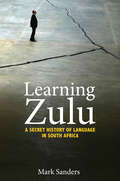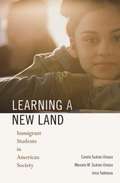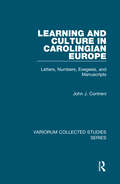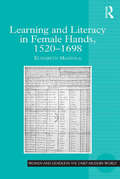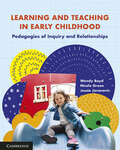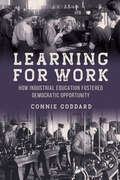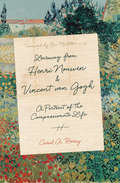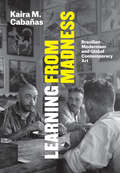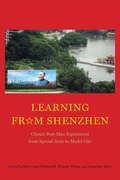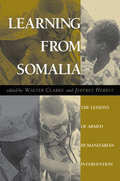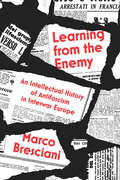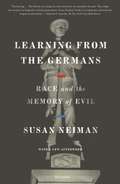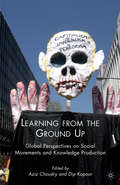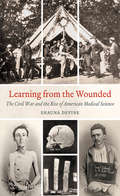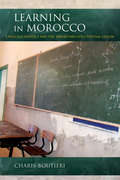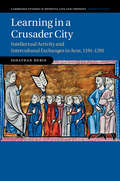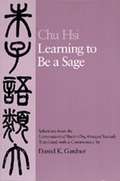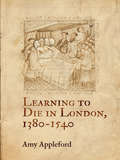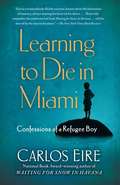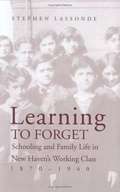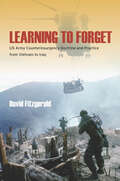- Table View
- List View
Learning Web Component Development
by Sandeep Kumar PatelThis book is the perfect reference for any web developer looking for an introduction to the new tools and techniques used to create web components.
Learning Zulu: A Secret History of Language in South Africa
by Mark Sanders"Why are you learning Zulu?" When Mark Sanders began studying the language, he was often asked this question. In Learning Zulu, Sanders places his own endeavors within a wider context to uncover how, in the past 150 years of South African history, Zulu became a battleground for issues of property, possession, and deprivation. Sanders combines elements of analysis and memoir to explore a complex cultural history.Perceiving that colonial learners of Zulu saw themselves as repairing harm done to Africans by Europeans, Sanders reveals deeper motives at work in the development of Zulu-language learning--from the emergence of the pidgin Fanagalo among missionaries and traders in the nineteenth century to widespread efforts, in the twentieth and twenty-first centuries, to teach a correct form of Zulu. Sanders looks at the white appropriation of Zulu language, music, and dance in South African culture, and at the association of Zulu with a martial masculinity. In exploring how Zulu has come to represent what is most properly and powerfully African, Sanders examines differences in English- and Zulu-language press coverage of an important trial, as well as the role of linguistic purism in xenophobic violence in South Africa. Through one person's efforts to learn the Zulu language, Learning Zulu explores how a language's history and politics influence all individuals in a multilingual society.
Learning a New Land: Immigrant Students in American Society, First Edition
by Marcelo M. Suarez-Orozco Carola Suarez-Orozco Irina TodorovaBased on an extraordinary interdisciplinary study that followed 400 newly arrived children from the Caribbean, China, Central America, and Mexico for five years, this book provides a compelling account of the lives, dreams, and frustrations of these youngest immigrants. Richly told portraits of high and low achievers are packed with unexpected ironies. When they arrive, most children are full of optimism and a respect for education. But poor neighborhoods and dull--often dangerous--schools can corrode hopes. The vast majority learn English--but it is the English of video games and the neighborhood, not that of standardized tests.
Learning and Culture in Carolingian Europe: Letters, Numbers, Exegesis, and Manuscripts (Variorum Collected Studies)
by John J. ContreniNine of the ten essays in this collection appeared first between 1995 and 2005. Centered in the Carolingian age, they explore how the seventh-century Visio Baronti was read in the ninth century and how social and cultural imperatives transformed the life of scholarship, schools and learning in Carolingian Europe. Several essays consider the significance of numerical and scientific studies in the Carolingian curriculum, including the impact of Bede's scientific works in the schools and on the thought of John Scottus (Eriugena). Another reconstructs Eriugena's early career in light of his Glossae divinae historiae. Carolingian biblical culture is the subject of two essays, including a reading of Haimo of Auxerre's commentary on Ezechiel that highlights the unfinished and unpublished commentary's critique of Carolingian society. A poem in the Anthologia Latina long ascribed to Octavian, the Roman emperor, is restored to the monastic culture of the ninth century. Finally, an article on the Laon Formulary, originally published in French in 1973, is here translated and revised.
Learning and Literacy in Female Hands, 1520-1698 (Women and Gender in the Early Modern World)
by Elizabeth MazzolaFocusing on the unusual learning and schooling of women in early modern England, this study explores how and why women wrote, the myriad forms their alphabets could assume, and the shape which vernacular literacy acquired in their hands. Elizabeth Mazzola argues that early modern women's writings often challenged the lessons of their male teachers, since they were designed to conceal rather than reveal women's learning and schooling. Employed by early modern women with great learning and much art, such difficult or ’resistant’ literacy organized households and administrative offices alike, and transformed the broader history of literacy in the West. Chapters treat writers like Jane Sharp, Anne Southwell, Jane Seager, Martha Moulsworth, Elizabeth Tudor, and Katherine Parr alongside images of women writers presented by Shakespeare and Sidney. Managing women's literacy also concerned early modern statesmen and secretaries, writing masters and grammarians, and Mazzola analyzes how both the emerging vernacular and a developing bureaucratic state were informed by these contests over women's hands.
Learning and Teaching in Early Childhood: Pedagogies of Inquiry and Relationships
by Nicole Green Wendy Boyd Jessie JovanovicLearning and Teaching in Early Childhood: Pedagogies of Inquiry and Relationships is an introduction for early childhood educators beginning their studies. Reflecting the fact that there is no single correct approach to the challenges of teaching, this book explores teaching through two lenses: teaching as inquiry and teaching as relating. The first part of the book focuses on inquiry, covering early childhood learning environments, learning theories, play pedagogies, approaches to teaching and learning, documentation and assessment, and the policy, curriculum and regulatory requirements in Australia. The second part explores relationships in early childhood contexts and covers topics such as fostering meaningful and respectful relationships with children, and working with families, staff and the wider community. Written by well-respected academics in the field, Learning and Teaching in Early Childhood is a vital resource for those entering the early childhood education and care profession.
Learning behind Bars: How IRA Prisoners Shaped the Peace Process in Ireland
by Deiter ReinischLearning behind Bars is an oral history of former Irish republican prisoners in the Republic of Ireland and Northern Ireland between 1971, the year internment was introduced, and 2000, when the high-security Long Kesh Detention Centre/HM Prison Maze closed. Dieter Reinisch outlines the role of politically motivated prisoners in ending armed conflicts as well as the personal and political development of these radical activists during their imprisonment. Based on extensive life-story interviews with Irish Republican Army (IRA) ex-prisoners, the book examines how political prisoners developed their intellectual positions through the interplay of political education and resistance. It sheds light on how prisoners used this experience to initiate the debates that eventually led to acceptance of the peace process in Northern Ireland. Politically relevant and instructive, Learning behind Bars illuminates the value of education, politics, and resistance in the harshest of social environments.
Learning for Work: How Industrial Education Fostered Democratic Opportunity
by Connie GoddardFounded in 1883, the Chicago Manual Training School (CMTS) was a short-lived but influential institution dedicated to teaching a balanced combination of practical and academic skills. Connie Goddard uses the CMTS as a door into America’s early era of industrial education and the transformative idea of “learning to do.” Rooting her account in John Dewey’s ideas, Goddard moves from early nineteenth century supporters of the union of learning and labor to the interconnected histories of CMTS, New Jersey’s Manual Training and Industrial School for Colored Youth, North Dakota’s Normal and Industrial School, and related programs elsewhere. Goddard analyzes the work of movement figures like abolitionist Theodore Weld, educators Calvin Woodward and Booker T. Washington, social critic W.E.B. Du Bois, Dewey himself, and his influential Chicago colleague Ella Flagg Young. The book contrasts ideas about manual training held by advocate Nicholas Murray Butler with those of opponent William Torrey Harris and considers overlooked connections between industrial education and the Arts and Crafts Movement. An absorbing merger of history and storytelling, Learning for Work looks at the people who shaped industrial education while offering a provocative vision of realizing its potential today.
Learning from Henri Nouwen and Vincent van Gogh: A Portrait of the Compassionate Life
by Carol A. BerryCarol Berry and her husband met and befriended Henri Nouwen when she sat in his course on compassion at Yale Divinity School in the 1970s. At the request of Henri Nouwen's literary estate, she has written this book, which includes unpublished material recorded from Nouwen's lectures. As an art educator, Berry is uniquely situated to develop Nouwen's work on Vincent van Gogh and to add her own research. She fills in background on the much misunderstood spiritual context of van Gogh's work, and reinterprets van Gogh's art (presented here in full color) in light of Nouwen's lectures. Berry also brings in her own experience in ministry, sharing how Nouwen and van Gogh, each in his own way, led her to the richness and beauty of the compassionate life.
Learning from Leonardo: Decoding the Notebooks of a Genius
by Fritjof CapraLeonardo da Vinci was a brilliant artist, scientist, engineer, mathematician, architect, inventor, writer, and even musician—the archetypal Renaissance man. But he was also, Fritjof Capra argues, a profoundly modern man. Not only did Leonardo invent the empirical scientific method over a century before Galileo and Francis Bacon, but Capra’s decade-long study of Leonardo’s fabled notebooks reveal him as a systems thinker centuries before the term was coined. He believed the key to truly understanding the world was in perceiving the connections between phenomena and the larger patterns formed by those relationships. This is precisely the kind of holistic approach the complex problems we face today demand. Capra describes seven defining characteristics of Leonardo da Vinci’s genius and includes a list of over forty discoveries Leonardo made that weren’t rediscovered until centuries later. Leonardo pioneered entire fields—fluid dynamics, theoretical botany, aerodynamics, embryology. Capra’s overview of Leonardo’s thought follows the organizational scheme Leonardo himself intended to use if he ever published his notebooks. So in a sense, this is Leonardo’s science as he himself would have presented it. Leonardo da Vinci saw the world as a dynamic, integrated whole, so he always applied concepts from one area to illuminate problems in another. For example, his studies of the movement of water informed his ideas about how landscapes are shaped, how sap rises in plants, how air moves over a bird’s wing, and how blood flows in the human body. His observations of nature enhanced his art, his drawings were integral to his scientific studies, and he brought art and science together in his extraordinarily beautiful and elegant mechanical and architectural designs. Obviously, we can’t all be geniuses on the scale of Leonardo da Vinci. But by exploring the mind of the preeminent Renaissance genius, we can gain profound insights into how best to address the challenges of the 21st century.
Learning from Madness: Brazilian Modernism and Global Contemporary Art
by Kaira M. CabañasThroughout the history of European modernism, philosophers and artists have been fascinated by madness. Something different happened in Brazil, however, with the “art of the insane” that flourished within the modernist movements there. From the 1920s to the 1960s, the direction and creation of art by the mentally ill was actively encouraged by prominent figures in both medicine and art criticism, which led to a much wider appreciation among the curators of major institutions of modern art in Brazil, where pieces are included in important exhibitions and collections. Kaira M. Cabañas shows that at the center of this advocacy stood such significant proponents as psychiatrists Osório César and Nise da Silveira, who championed treatments that included painting and drawing studios; and the art critic Mário Pedrosa, who penned Gestaltist theses on aesthetic response. Cabañas examines the lasting influence of this unique era of Brazilian modernism, and how the afterlife of this “outsider art” continues to raise important questions. How do we respect the experiences of the mad as their work is viewed through the lens of global art? Why is this art reappearing now that definitions of global contemporary art are being contested?Learning from Madness offers an invigorating series of case studies that track the parallels between psychiatric patients’ work in Western Europe and its reception by influential artists there, to an analogous but altogether distinct situation in Brazil.
Learning from Shenzhen: China’s Post-Mao Experiment from Special Zone to Model City
by Jonathan Bach Mary Ann O'Donnell Winnie WongThis multidisciplinary volume, the first of its kind, presents an account of China’s contemporary transformation via one of its most important yet overlooked cities: Shenzhen, located just north of Hong Kong. In recent decades, Shenzhen has transformed from an experimental site for economic reform into a dominant city at the crossroads of the global economy. The first of China’s special economic zones, Shenzhen is today a UNESCO City of Design and the hub of China’s emerging technology industries. Bringing China studies into dialogue with urban studies, the contributors explore how the post-Mao Chinese appropriation of capitalist logic led to a dramatic remodeling of the Chinese city and collective life in China today. These essays show how urban villages and informal institutions enabled social transformation through cases of public health, labor, architecture, gender, politics, education, and more. Offering scholars and general readers alike an unprecedented look at one of the world’s most dynamic metropolises, this collective history uses the urban case study to explore critical problems and possibilities relevant for modern-day China and beyond.
Learning from Somalia: The Lessons of Armed Humanitarian Intervention
by Walter S Clarke<p>The U.S.-led intervention in Somalia that began in December 1992 is the most significant instance to date of “peacemaking” by the international community. The heady promise of Operation Restore Hope and the subsequent disappointments have had a resounding impact on the policies of Western governments and the UN as they have tried to cope with humanitarian emergencies in Rwanda, Bosnia, and elsewhere. However, it is questionable how correct the lessons so quickly derived from the Somalia experience actually were. At the same time, many important organizational and operational innovations during the Somalia exercise have not received sufficient attention. Learning from Somalia is therefore critical if the international community is to respond better to tragedies that threaten millions of human lives. <p>Contributors to this book, many of whom are policymakers who were either in Mogadishu or Washington during the relief missions, examine the intervention in Somalia and draw lessons for future peacekeeping operations. They analyze many aspects of peacemaking that are not well understood, including efforts to rebuild the police force, the dynamics of the economy, the relationship between the military and nongovernmental organizations, and the performance of European armies. The book also discusses international politics surrounding the crisis, especially the relationship between the United States and the UN and the legal justifications for intervention. The concluding chapters discuss the prospects for intervention efforts in light of the Somalia experience.
Learning from the Enemy: An Intellectual History of Antifascism in Interwar Europe
by Marco BrescianiThe first comprehensive history of an Italian revolutionary group that fought fascism in interwar Europe and pursued a liberal socialist project beyond itThis Italian antifascist revolutionary group "Giustizia e Libertà" operated both in emigration and as part of the clandestine resistance, offering radical responses to the rise of Fascism, Nazism and Stalinism. How to understand and fight fascism? How to rethink politics in the maelstrom of crisis that shook Italian and European society in the 1930s? How to design a new post-fascist order out of the ruins of the Great War?To answer these questions "Giustizia e Libertà," founded by Carlo Rosselli in Paris in 1929 and disbanded in 1940, developed several revolutionary projects and linked socialist and liberal traditions in innovative ways, inspired by French and European culture.Their debates focused on fascism as a product of a post-1914 civilizational crisis and a key political, social, cultural phenomenon of the interwar period. To struggle against its enemy, the group aimed to go beyond the Marxist notion of class and to assert different concepts of nation and Europe, while elaborating lucid comparative thoughts on tyrannies.
Learning from the Germans: Race and the Memory of Evil
by Susan NeimanAs an increasingly polarized America fights over the legacy of racism, Susan Neiman, author of the contemporary philosophical classic Evil in Modern Thought, asks what we can learn from the Germans about confronting the evils of the pastIn the wake of white nationalist attacks, the ongoing debate over reparations, and the controversy surrounding Confederate monuments and the contested memories they evoke, Susan Neiman’s Learning from the Germans delivers an urgently needed perspective on how a country can come to terms with its historical wrongdoings. Neiman is a white woman who came of age in the civil rights–era South and a Jewish woman who has spent much of her adult life in Berlin. Working from this unique perspective, she combines philosophical reflection, personal stories, and interviews with both Americans and Germans who are grappling with the evils of their own national histories.Through discussions with Germans, including Jan Philipp Reemtsma, who created the breakthrough Crimes of the Wehrmacht exhibit, and Friedrich Schorlemmer, the East German dissident preacher, Neiman tells the story of the long and difficult path Germans faced in their effort to atone for the crimes of the Holocaust. In the United States, she interviews James Meredith about his battle for equality in Mississippi and Bryan Stevenson about his monument to the victims of lynching, as well as lesser-known social justice activists in the South, to provide a compelling picture of the work contemporary Americans are doing to confront our violent history. In clear and gripping prose, Neiman urges us to consider the nuanced forms that evil can assume, so that we can recognize and avoid them in the future.
Learning from the Ground Up
by Aziz Choudry Dip KapoorThe dynamics, politics, and richness of knowledge production in social movements and social activist contexts are often overlooked. This book contends that some of the most radical critiques and understandings about dominant ideologies and power structures, and visions of social change, have emerged from those spaces.
Learning from the Wounded
by Shauna DevineNearly two-thirds of the Civil War's approximately 750,000 fatalities were caused by disease--a staggering fact for which the American medical profession was profoundly unprepared. In the years before the war, training for physicians in the United States was mostly unregulated, and medical schools' access to cadavers for teaching purposes was highly restricted. Shauna Devine argues that in spite of these limitations, Union army physicians rose to the challenges of the war, undertaking methods of study and experimentation that would have a lasting influence on the scientific practice of medicine. Though the war's human toll was tragic, conducting postmortems on the dead and caring for the wounded gave physicians ample opportunity to study and develop new methods of treatment and analysis, from dissection and microscopy to new research into infectious disease processes. Examining the work of doctors who served in the Union Medical Department, Devine sheds new light on how their innovations in the midst of crisis transformed northern medical education and gave rise to the healing power of modern health science.
Learning in Morocco: Language Politics and the Abandoned Educational Dream
by Charis BoutieriLearning in Morocco offers a rare look inside public education in the Middle East. While policymakers see a crisis in education based on demographics and financing, Moroccan high school students point to the effects of a highly politicized Arabization policy that has never been implemented coherently. In recent years, national policies to promote the use of Arabic have come into conflict with the demands of a neoliberal job market in which competence in French is still a prerequisite for advancement. Based on long-term research inside and outside classrooms, Charis Boutieri describes how students and teachers work within, or try to circumvent, the system, whose contradictory demands ultimately lead to disengagement and, on occasion, to students taking to the streets in protest.
Learning in a Crusader City: Intellectual Activity and Intercultural Exchanges in Acre, 1191–1291 (Cambridge Studies in Medieval Life and Thought: Fourth Series #110)
by Jonathan RubinDid the Crusades trigger significant intellectual activity? To what extent and in what ways did the Latin residents of the Crusader States acquire knowledge from Muslims and Eastern Christians? And how were the Crusader states influenced by the intellectual developments which characterized the West in the twelfth and thirteenth centuries? This book is the first to examine these questions systematically using the complete body of evidence from one major urban centre: Acre. This reveals that Acre contained a significant number of people who engaged in learned activities, as well as the existence of study centres housed within the city. This volume also seeks to reconstruct the discourse that flowed across four major fields of learning: language and translation, jurisprudence, the study of Islam, and theological exchanges with Eastern Christians. The result is an unprecedentedly rich portrait of a hitherto neglected intellectual centre on the Eastern shores of the medieval Mediterranean.
Learning to Be a Sage: Selections from the Conversations of Master Chu, Arranged Topically
by Hsi Chu Daniel K. GardnerDaniel Gardner's translation of the teachings of Chu Hsi (1130-1200)--a luminary of the Confucian tradition who dominated Chinese intellectual life for centuries focuses on Chu Hsi's passionate interest in education and its importance to individual development.
Learning to Die in London, 1380-1540
by Amy ApplefordTaking as her focus a body of writings in poetic, didactic, and legal modes that circulated in England's capital between the 1380s--just a generation after the Black Death--and the first decade of the English reformation in the 1530s, Amy Appleford offers the first full-length study of the Middle English "art of dying" (ars moriendi). An educated awareness of death and mortality was a vital aspect of medieval civic culture, she contends, critical not only to the shaping of single lives and the management of families and households but also to the practices of cultural memory, the building of institutions, and the good government of the city itself. In fifteenth-century London in particular, where an increasingly laicized reformist religiosity coexisted with an ambitious program of urban renewal, cultivating a sophisticated attitude toward death was understood as essential to good living in the widest sense. The virtuous ordering of self, household, and city rested on a proper attitude toward mortality on the part both of the ruled and of their secular and religious rulers. The intricacies of keeping death constantly in mind informed not only the religious prose of the period, but also literary and visual arts. In London's version of the famous image-text known as the Dance of Death, Thomas Hoccleve's poetic collection The Series, and the early sixteenth-century prose treatises of Tudor writers Richard Whitford, Thomas Lupset, and Thomas More, death is understood as an explicitly generative force, one capable (if properly managed) of providing vital personal, social, and literary opportunities.
Learning to Die in Miami: Confessions of a Refugee Boy
by Carlos EireContinuing the personal saga begun in the National Book Award-winning Waiting for Snow in Havana, the inspiring, sad, funny, bafflingly beautiful story of a boy uprooted by the Cuban Revolution and transplanted to Miami during the years of the Kennedy administration.In his 2003 National Book Award–winning memoir Waiting for Snow in Havana, Carlos Eire narrated his coming of age in Cuba just before and during the Castro revolution. That book literally ends in midair as eleven-year-old Carlos and his older brother leave Havana on an airplane—along with thousands of other children—to begin their new life in Miami in 1962. It would be years before he would see his mother again. He would never again see his beloved father. Learning to Die in Miami opens as the plane lands and Carlos faces, with trepidation and excitement, his new life. He quickly realizes that in order for his new American self to emerge, his Cuban self must &“die.&” And so, with great enterprise and purpose, he begins his journey. We follow Carlos as he adjusts to life in his new home. Faced with learning English, attending American schools, and an uncertain future, young Carlos confronts the age-old immigrant&’s plight: being surrounded by American bounty, but not able to partake right away. The abundance America has to offer excites him and, regardless of how grim his living situation becomes, he eagerly forges ahead with his own personal assimilation program, shedding the vestiges of his old life almost immediately, even changing his name to Charles. Cuba becomes a remote and vague idea in the back of his mind, something he used to know well, but now it &“had ceased to be part of the world.&” But as Carlos comes to grips with his strange surroundings, he must also struggle with everyday issues of growing up. His constant movement between foster homes and the eventual realization that his parents are far away in Cuba bring on an acute awareness that his life has irrevocably changed. Flashing back and forth between past and future, we watch as Carlos balances the divide between his past and present homes and finds his way in this strange new world, one that seems to hold the exhilarating promise of infinite possibilities and one that he will eventually claim as his own. An exorcism and an ode, Learning to Die in Miami is a celebration of renewal—of those times when we&’re certain we have died and then are somehow, miraculously, reborn.
Learning to Fight: Military Innovation and Change in the British Army, 1914–1918 (Cambridge Military Histories)
by Aimée FoxLearning, innovation and adaptation are not concepts that we necessarily associate with the British army of the First World War. Yet the need to learn from mistakes, to exploit new opportunities and to adapt to complex situations are enduring and timeless. This revealing work is the first institutional examination of the army's process for learning during the First World War. Drawing on organisational learning and management theories, Aimée Fox critiques existing approaches to military learning in wartime. Focused around a series of case studies, the book ranges across multiple operational theatres and positions the army within a broader context in terms of its relationships with allies and civilians to reveal that learning was more complex and thoroughgoing than initially thought. It grapples with the army's failings and shortcomings, explores its successes and acknowledges the inherent difficulties of learning in a desperate and lethally competitive environment. Analyses multiple operational theatres, allowing readers to better understand the challenges facing the British army during the war. Proposes a new model for learning in military organisations which will appeal to anyone interested in the challenges of learning in complex organisations. Provides a new and illuminating case study on organisational learning and innovation that demonstrates how innovation is not the preserve of modern military forces.
Learning to Forget: Schooling and Family Life in New Haven's Working Class, 1870-1940
by Stephen LassondeThis book offers an insightful view of the complex relations between home and school in the working-class immigrant Italian community of New Haven, Connecticut. Through the lenses of history, sociology, and education, Learning to Forget presents a highly readable account of cross-generational experiences during the period from 1870 to 1940, chronicling one generation's suspicions toward public education and another's need to assimilate. Through careful research Lassonde finds that not all working class parents were enthusiastic supporters of education. Not only did the time and energy spent in school restrict children's potential financial contributions to the family, but attitudes that children encountered in school often ran counter to the family's traditional values. Legally mandated education and child labor laws eventually resolved these conflicts, but not without considerable reluctance and resistance.
Learning to Forget: US Army Counterinsurgency Doctrine and Practice from Vietnam to Iraq
by David FitzgeraldLearning to Forgetanalyzes the evolution of US counterinsurgency (COIN) doctrine over the last five decades. Beginning with an extensive section on the lessons of Vietnam, it traces the decline of COIN in the 1970s, then the rebirth of low intensity conflict through the Reagan years and the conflict in Bosnia, culminating in the campaigns in Iraq and Afghanistan. It explains how the lessons of Vietnam led the Army to Iraq and the way in which their confronting and reimagining of these lessons offered them a way out of that war. In the process it provides an illustration of how military leaders make use of history and demonstrates the difficulties of drawing lessons from the past that can usefully be applied to contemporary circumstances. The book outlines how the construction of lessons is tied to the construction of historical memory and describes the interplay between the two processes—demonstrating how histories are constructed to serve the needs of the present. In so doing, it creates a new theory of doctrinal development.

